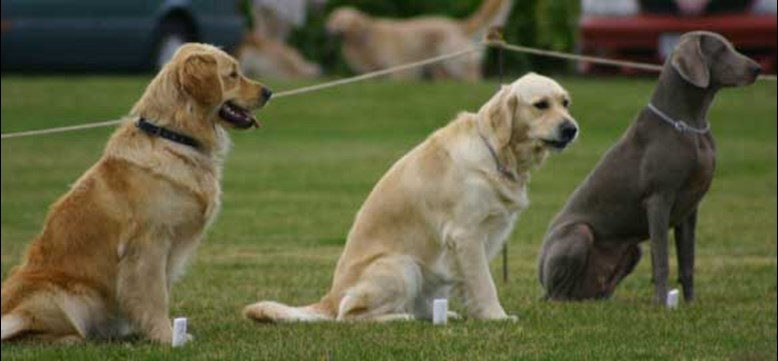Obedience
About Obedience
There is nothing more satisfying than sharing your life with a well trained canine companion. Reaching that goal is attainable and takes time, commitment and consistency and whether your dog is a puppy or a mature dog training will assist you in sharing a special relationship where your dog is a pleasure to have by your side, whether at home or in a social situation.
The day your puppy or more mature dog comes into your home is the day the dog starts to learn the rules by which you expect him to live. He will need to get out and meet the world with all its noises and movements and this can start at 8-12 weeks attending Puppy Pre School which is usually run by a Vet Clinic. The next step is to register at your local dog training club in Victoria. Puppies can be registered at training clubs when they have received their final vaccinations usually at approximately 12 – 16 weeks.
Trained club Instructors will teach you to train your dog. This is the beginning of a special partnership you and your dog will share and build upon while learning to work as a team. Your puppy will learn to walk on lead without pulling, to sit, stay, drop and stand using voice and hand signals and the very important command, to come when called. As you and your dog gain confidence and learn new skills you will progress through the classes building on those skills already acquired. Once you and your dog are working well together there are other avenues where you can continue to develop skills and learn more and be introduced to the world of Obedience Trialling and Rally Obedience.
Whether your dog is a puppy or a more mature dog, has a pedigree, is a rescue dog, or is a mixed breed the basic training he has received at the local obedience club will enable you and your dog to get ready to enter the world of Obedience Trialling and Rally Obedience. To enter in these competitions you need a trained dog that is registered with a controlling body, in Victoria that is Dogs Victoria, either on the main register, limited register or associate register. You also need to be a member of Dogs Victoria.
Please be warned that Obedience Trialling and Rally Obedience will open up a new world for you and your dog. Some people newly introduced to the world of obedience find trialling addictive and each weekend people head off with their dogs to compete in Obedience and Rally O, along the way forming friendships with like minded people. Often people go on to find other avenues in which they can compete with their dog, but no matter what dog sport is chosen, obedience is the key and is the basis of all training to have control over your dog.
There are five levels of Obedience in Australia plus Rally Obedience which also has different levels from Novice through to Master. All classes and rules are explained fully in the Obedience and Rally Obedience Rule Books which can be sourced from Dogs Victoria.
Obedience Competitions
There are five levels of obedience in Australia;
- CCD
- CD
- CDX
- UD and
- UDX
Each level becomes progressively more challenging.
A title is achieved when the dog has three passes at that level. Most levels require a pass of 170 points or more out of 200, and the dog must pass every exercise within the level.
The exception is the entry class of Community Companion Dog which requires 85 points out of 100. All the exercises are based on useful things dogs can do for us and which make for a better companion.
Community Companion Dog - CCD
This is the basic level of competition and is not a compulsory section.
In this class the exercises are:
- the dog and handler work together as a team to perform a heel on lead exercise, including sits, stands and downs as the judge calls them.
- next is stand for examination where the dog stands steadily on lead whilst the judge approaches and examines the dog’s back and head.
- finally the dog is left sitting whilst the handler walks away 12 metres then turns and calls the dog, which should come straight in and sit in front, the handler returns around it and releases, usually with much praise for a job well done.
- when all dogs in the class have had their turn, they all come together to do a one minute sit stay and a two minute down stay, all off lead in a row with the handlers standing five metres away.
Three passes of a minimum 85 points out of a possible 100 points under at least two different judges will qualify the dog for the award Community Companion Dog, which follows after the dog's name and is normally abbreviated to CCD.
Companion Dog - CD
Obedience trialling at the Novice level consists of the performance of a number of exercises in a formal ring situation. These exercises are:
- the heeling exercise is off lead so it requires a lot more input and concentration from the dog to stay with the handler
- the stand for examination is also off lead with the handler standing two metres away
- the recall is a bit longer at 15 metres and after the dog comes in and sits, it must return to the handler and sit at heel on the left side.
- the last exercise has a handler’s choice between retrieving a dumbbell over four metres or the dog doing a change of position where it is left in a stand and, with the handler three metres in front, goes into the down on command and stays there whilst the handler returns around it.
- the stay exercises are harder too, the sit for a minute and the down for three minutes and the handlers are all 10 metres away.
Three passes of a minimum of 170 points out of a possible 200 under at least two different judges will qualify the dog for the award Companion Dog, which follows after the dog's name and is normally abbreviated to CD.
Companion Dog Excellent - CDX
Most dogs enjoy this, it’s fun, but the expected standard of the work is higher and introduces jumping, and stays in which the handler is out of sight. The formal exercises are:
- the heeling is off lead and more demanding.
- the stand for examination has the handler five metres away and the judge touches all of the dog, except its mouth and tail.
- the recall has a drop somewhere in the middle, when the judge says, and the dog must remain in the down position until called in.
- the dog retrieves a dumbbell thrown at least six metres, sits in front, lets the handler take it, and returns to the handler’s left side.
- the other retrieve is the handler’s choice of retrieve a dumbbell thrown four metres over a solid jump or a directed retrieve of a glove at 10 metres distance.
- next comes a handler’s choice between jumping over a broad jump and returning to the handler or a change of position where the dog is left in a stand and does a down and sit on the spot then recalls to the handler.
- the stays have the handlers all leaving the ring and waiting out of sight nearby whilst the dogs do a three minute sit and a five minute down stay.
Three passes of a minimum of 170 points out of a possible 200 under at least two different judges will qualify the dog for the award Companion Dog Excellent, which follows after the dog's name and is normally abbreviated to CDX.
Utility Dog - UD
This gets really hard because the dog has to leave the handler and perform tasks which are more complex, although it looks easy watching a well-trained dog going through the exercises. It introduces scent work, and demands a high level of training and understanding between dog and handler. The formal exercises are:
- first is the seek back, where the dog and handler heel around the ring to make a track and somewhere along the track an article carrying the handler’s scent is placed, then the dog has to go and find this and bring it back and present it to the handler.
- most dogs love directed jumping where they run out 25 metres and sit in a square frame, then return to the handler over a bar jump or a solid jump on either side of the ring, whichever the handler points to.
- the dog performs scent discrimination, either on a canvas mat or on the ground, there are 12 articles of metal, wood and leather put out by the judge or steward, and the dog is sent to the articles to retrieve a similar article which the handler has touched, this is done three times, once for each sort of article.
- the heeling exercise is harder because it is all done by signals only, no voice commands allowed, and at the end the dog is left in the stand, the handler signals it to down, sit, recall and finish.
- a choice of three exercises, the dog can speak on command where it barks in two positions, the sit, stand or drop, or it can do food refusal where it refuses offered food in two positions, the sit, stand or drop or it may do directed retrieve where it retrieves the designated glove out of three placed six metres apart.
- the stand for examination is done as a group exercise.
- the only stay exercise is a five minute down with the handlers out of sight nearby.
Three passes of a minimum of 170 points out of a possible 200 under at least two different judges will qualify the dog for the award Utility Dog, which follows after the dog's name and is normally abbreviated to UD.
Utility Dog Excellent - UDX
The exercises at this level extend on those in the Utility section but there is no jumping, so it suits our older dogs. The exercises are:
- the seek back is as in utility but there is a decoy article scented by someone else which the dog must not retrieve.
- a heeling pattern, positions in motion, in which signals or voice may be used, and three times the dog is left in a sit, a stand or a drop whilst the handler walks forward five metres, returns three metres past the dog and returns, collecting the dog on the way.
- the scent discrimination is finding a cloth article scented by the judge from amongst unscented ones.
- a two part exercise, directed send away and recall in which the dog goes out 25 metres and sits in a square marked by four cones, the handler walks towards the dog and, when instructed, turns and calls the dog to heel, does a right or left turn then a halt, with the dog at heel by this time.
- distance control where the dog is left in a stand and changes position six times as the judge instructs, including sits, stands and downs, all on the spot.
- the dog retrieves two articles, following the handler’s direction signal.
- the last exercise is a group stand for examination with the handlers facing away from the dogs.
Three passes of a minimum of 170 points out of a possible 200 under at least two different judges will qualify the dog for the award Utility Dog Excellent, which follows after the dog's name and is normally abbreviated to UDX.
Obedience Champion - O Ch
All Obedience titles are shown after the dog’s name and in fact become part of the registered name of the dog. If the dog achieves the title of – obedience champion - this title is shown before the name as O Ch.
If you want to know more about the serious side of obedience trialing, you should purchase a copy of the obedience rule book, available from Dogs Victoria or download it from the Dogs Australia website.
OTEC Extreme Weather Policy
This document is intended for use by clubs where extreme weather occurs at a trial/s where the health and safety of officials, competitors and dogs could be affected. In applying this policy, it must be remembered that both people and dogs are affected in similar ways by weather conditions such as high temperatures; high humidity, hot and gale force winds, thunderstorms, lightning or intense rain/flooding.
This policy applies when the temperature exceeds 35 degrees. The club must provide a suitable outdoor thermometer to monitor the temperature as per the current OTEC Extreme Weather Policy.
When the Obedience, Tracking and Endurance Committee Extreme Weather Policy is invoked, all requirements of that policy must be adhered to. (Regulation 9.1.3.2)
Click here to read the complete OTEC Extreme Weather Policy.
The Victoria Canine Association Inc has no connection or affiliation with D.O.G.S. of Vic Pty Ltd. If you are looking for D.O.G.S. of Vic Pty Ltd, please contact them directly on 03 9898 2100




.png)

